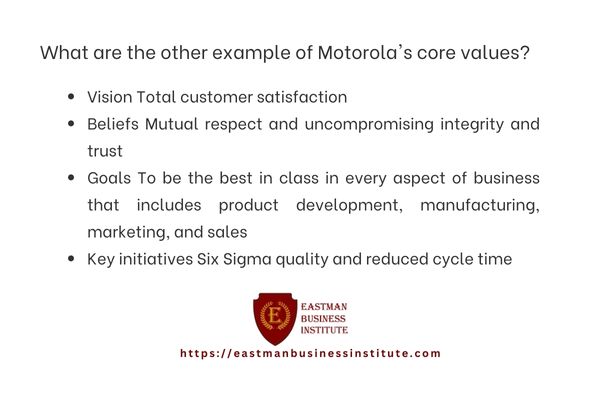In the annals of corporate innovation and excellence, the journey of Six Sigma at Motorola – The First Success Story stands as a monumental beacon, illuminating the path for companies striving for unparalleled quality and operational efficiency. This narrative isn’t just about a certification program or a set of tools for data analysis; it’s a testament to a revolutionary business strategy that transformed Motorola into a paragon of lean manufacturing and total quality management.
By intricately weaving statistical process control with a relentless pursuit of reducing standard deviation, Motorola not only elevated its process capability but also set a new benchmark in statistical quality control, effectively marrying the principles of Lean and Six Sigma.
Read more about Six Sigma at Motorola – The First Success Story

As we delve into this pioneering success story, we uncover the essence of business process refinement, strategy redefinition, and the unwavering commitment to excellence that propelled Motorola to its zenith. This tale is not merely historical; it’s a blueprint for modern enterprises aiming to achieve operational excellence through the disciplined application of Six Sigma and Lean methodologies.
More Things To Know About Six Sigma at Motorola – The First Success Story

History of Six Sigma at Motorola
To understand the origin of Six Sigma at Motorola, delve into the early 1980s when the methodology was first introduced by Bill Smith.
At that time, Motorola Solutions sought to enhance its quality management and process improvement strategies. Bill Smith, an engineer at Motorola, developed the Six Sigma methodology as a way to systematically improve processes by identifying and removing causes of defects and errors.
By focusing on reducing variation and enhancing efficiency, Six Sigma quickly gained traction within Motorola Solutions. This marked the beginning of a transformative journey for the company, leading to significant improvements in product quality, customer satisfaction, and overall operational performance.
The origins of Six Sigma at Motorola set the stage for its widespread adoption across industries worldwide.
Key people involved in the development of Six Sigma at Motorola
During the inception of Six Sigma at Motorola, key individuals such as Bill Smith and top executives played pivotal roles in shaping the methodology’s development and implementation. Bill Smith, an engineer at Motorola, is often credited with creating the Six Sigma methodology in the mid-1980s. His innovative approach to quality management revolutionized the company’s processes.
Top executives at Motorola, including the leadership at the time, recognized the potential of Six Sigma and championed its adoption throughout the organization. This commitment to quality improvement laid the foundation for Motorola’s success and set a precedent for other companies to follow suit.
Notably, Jack Welch, the former CEO of General Electric, later popularized Six Sigma at General Electric, demonstrating its effectiveness beyond Motorola Mobility.
The motivation behind the adoption of Six Sigma
Motorola’s decision to adopt Six Sigma stemmed from a pressing need to enhance quality, reduce defects, and stay competitive in the rapidly evolving market. The company was facing increasing customer demands and intensifying global competition, prompting a shift towards a more data-driven and systematic approach.
Understanding Six Sigma
To understand Six Sigma, grasp its core concept of minimizing variation in processes to achieve near-perfect quality. Originating at Motorola, Six Sigma became a renowned success story due to its rigorous principles.
The methodology emphasizes data-driven decision-making, focusing on customer satisfaction by reducing defects and enhancing efficiency. Motorola’s implementation of Six Sigma led to substantial cost savings, improved processes, and heightened customer loyalty.
The principles of Six Sigma revolve around defining, measuring, analyzing, improving, and controlling processes to enhance overall performance. By integrating statistical tools and techniques, organizations can methodically identify and eliminate defects, ultimately striving for a sigma level of six – equivalent to only 3.4 defects per million opportunities.
Embracing these principles can drive significant improvements in quality and operational excellence.
The DMAIC process in Six Sigma
During the implementation of Six Sigma at Motorola, you’ll navigate the DMAIC process to enhance quality and efficiency in your organization. The DMAIC process – Define, Measure, Analyze, Improve, and Control – is a fundamental part of the Six Sigma methodology.
At Motorola, this process played a pivotal role in their success story by providing a structured approach to problem-solving and process improvement. By defining the problem, measuring key aspects, analyzing data to identify root causes, implementing improvements, and establishing controls to sustain the enhancements, Motorola was able to achieve significant quality and efficiency gains.
Embracing the DMAIC process within your organization, as Motorola did, can lead to substantial improvements and drive success in your business endeavors.
Importance of Six Sigma in quality management
Navigating the DMAIC process in Six Sigma at Motorola demonstrated the crucial role of structured problem-solving and process improvement in achieving significant quality and efficiency gains. Six Sigma plays a pivotal role in quality management by providing a systematic approach to enhancing processes and reducing defects in manufacturing.
By implementing Six Sigma methodologies, organizations can streamline operations, minimize variability, and ensure consistent quality outputs. This disciplined approach not only leads to improved customer satisfaction but also boosts operational performance and profitability.
The emphasis on process improvement within Six Sigma enables companies to identify root causes of issues, implement data-driven solutions, and sustain quality standards over time. In essence, Six Sigma acts as a cornerstone in driving continuous improvement and excellence in quality management practices.
Implementation of Six Sigma at Motorola
To implement Six Sigma at Motorola, a comprehensive plan outlining specific steps for deployment was developed. Motorola initiated the implementation by forming a dedicated team of experts to oversee the Six Sigma process. This team received extensive training in Six Sigma methodologies to ensure a deep understanding of the principles.
Next, the company identified key projects where Six Sigma could be applied to drive improvements in quality and efficiency. These projects were carefully selected based on their potential impact on the organization’s overall performance. Once the projects were identified, clear goals and objectives were established to guide the implementation process.
Regular monitoring and feedback mechanisms were put in place to track progress and make necessary adjustments along the way.
Challenges faced during the implementation process
Some of the challenges faced during the implementation process include resistance to change from employees accustomed to traditional methods, the need for extensive training to ensure all staff understand and embrace the Six Sigma principles, and the requirement for significant time and resource investments to support the transition.
Aligning Six Sigma projects with organizational goals and ensuring consistent top-level management support throughout the implementation process can pose significant challenges. Overcoming these hurdles demands strong leadership, effective communication strategies, and a commitment to continuous improvement.
Despite the challenges, successfully navigating the implementation phase at Motorola can lead to substantial quality improvements, cost reductions, and overall business success.
Role of leadership in the implementation of Six Sigma at Motorola
Navigating the implementation of Six Sigma at Motorola requires strong leadership to overcome challenges and drive successful adoption throughout the organization. Leadership plays a pivotal role in the success story of Six Sigma at Motorola by setting the vision, providing resources, and fostering a culture of continuous improvement.
Effective leaders communicate the importance of Six Sigma, align it with strategic objectives, and empower employees to participate actively in the implementation process. They act as change agents, guiding teams through the methodology, removing roadblocks, and celebrating achievements.
Through their commitment and involvement, leaders inspire confidence in the Six Sigma process, ensuring its integration into the organizational DNA and contributing to sustained performance improvement.
Impact of Six Sigma on Motorola’s Performance
The adoption of Six Sigma at Motorola marked a pivotal transformation in the company’s approach to improving its business processes. As the pioneering American company to implement this strategy, Motorola not only enhanced the quality of its products but also set a benchmark for operational excellence globally. Through the rigorous training and certification of Six Sigma practitioners, including the Six Sigma White Belt and Green Belt certification programs, Motorola cultivated a culture of continuous improvement and lean Six Sigma methodologies.
This strategic move significantly contributed to streamlining operations, reducing waste, and elevating product quality. The impact was profound, as Motorola’s Six Sigma implementations resonated across the industry, inspiring the American Society for Quality and other organizations to advocate for Six Sigma methodologies. By harnessing the power of Six Sigma, Motorola demonstrated how an American company could dramatically improve quality, foster innovation, and maintain a competitive edge in the global market.
Quantitative improvements in Motorola’s performance due to Six Sigma
Achieved through rigorous implementation, Six Sigma significantly enhanced Motorola’s performance metrics. The application of the Six Sigma methodology led to substantial quality improvement and process enhancement across various departments within the company. By focusing on reducing defects and variations, Motorola experienced a remarkable boost in performance levels.
The table below highlights the quantitative improvements in Motorola’s performance directly attributed to the successful implementation of Six Sigma:
| Performance Metric | Improvement Achieved | Area of Impact |
|---|---|---|
| Defect Rate | 95% reduction | Manufacturing |
| Cycle Time | 50% decrease | Supply Chain |
| Customer Satisfaction | 20% increase | Sales and Service |
| Cost Reduction | $1 million savings | Operations |
Qualitative improvements in Motorola’s operations
Improving operational efficiency through Six Sigma methodologies has been a transformative journey for Motorola, enhancing performance across various aspects of the company. By implementing Six Sigma’s rigorous quality control measures, Motorola has significantly improved its process efficiency and effectiveness.
The focus on process improvement has led to streamlined operations, reduced defects, and enhanced product quality. Through Six Sigma, Motorola has been able to align its operations more closely with customer requirements, ultimately boosting customer satisfaction levels.
These qualitative enhancements in Motorola’s operations haven’t only increased the overall quality of products and services but have also contributed to a more customer-centric approach, solidifying Motorola’s position as a leader in the industry.
Criticisms of Six Sigma’s implementation at Motorola
Despite its success, criticisms have been raised about the implementation of Six Sigma at Motorola. Some detractors argue that the rigid structure of Six Sigma can stifle innovation and creativity within an organization like Motorola.
They claim that a hyper-focus on metrics and processes may lead to a lack of flexibility in addressing dynamic market conditions. There are concerns that the extensive training and resources required for Six Sigma implementation can be costly and time-consuming, potentially diverting attention from other crucial business initiatives.
Critics also point out that the emphasis on achieving statistical perfection may not always align with the practical realities of business operations at Motorola, leading to frustration among employees and managers.
Controversies surrounding the impact of Six Sigma on Motorola’s performance
Controversies surround the impact of Six Sigma on Motorola’s performance, raising questions about its effectiveness and implications.
While Six Sigma brought significant success to Motorola in terms of quality improvement and cost reduction, critics argue that the methodology may have led to a culture of rigidity and stifled innovation within the organization.
Some controversies stem from the intense focus on statistical methods, which could overshadow the human element in problem-solving processes.
There are concerns that the stringent requirements of Six Sigma may not always be suitable for every project or industry, leading to potential inefficiencies.
Despite its successes, the controversy surrounding Six Sigma at Motorola highlights the ongoing debate about the methodology’s universal applicability and long-term impact on organizational performance.
Motorola’s response to these criticisms and controversies
In response to the criticisms and controversies surrounding Six Sigma’s impact on Motorola’s performance, the company implemented strategies to address concerns and enhance the methodology’s effectiveness.
Motorola actively engaged in quality management initiatives to refine its Six Sigma processes, ensuring that operational excellence remained a top priority. By acknowledging the feedback received and incorporating necessary adjustments, Motorola demonstrated its commitment to continuous improvement and adaptability.
Through these efforts, the company aimed to strengthen its position as a leader in the application of Six Sigma methodologies, showcasing a dedication to quality and efficiency in all facets of its operations. Motorola’s proactive approach to addressing criticisms underscored its commitment to excellence and innovation within the realm of quality management and operational efficiency.
Key lessons learned from Motorola’s Six Sigma journey
Throughout Motorola’s Six Sigma journey, significant insights have been gained regarding process improvement and organizational efficiency. One key lesson learned is the importance of data-driven decision-making. Motorola’s success story with Six Sigma showcases how utilizing statistical tools and analysis can lead to tangible improvements in quality and cost reduction.
Another crucial lesson is the significance of leadership buy-in and support. Without top-level commitment to the Six Sigma methodology, implementation and sustainability become challenging. Fostering a culture of continuous improvement and employee empowerment proved instrumental for Motorola. By encouraging employees to actively participate in problem-solving and decision-making processes, Six Sigma thrived within the organization, driving long-term success and profitability.
The influence of Motorola’s Six Sigma success on other companies
Motorola’s Six Sigma success has inspired numerous companies to adopt similar quality improvement practices. By showcasing tangible results and cost savings through their success story, Motorola became a beacon for organizations seeking operational excellence.
The influence of Motorola’s Six Sigma implementation has been profound, leading to a widespread adoption of the methodology across industries globally. Companies recognize the transformative power of Six Sigma in enhancing efficiency, reducing defects, and ultimately improving customer satisfaction.
Motorola’s success serves as a testament to the impact of disciplined problem-solving and data-driven decision-making. As a result, many companies have integrated Six Sigma principles into their operations, striving for the same level of excellence that propelled Motorola to the forefront of quality management practices.
Future implications of Six Sigma for quality management in the tech industry
The tech industry’s quality management stands to benefit significantly from the future implications of Six Sigma, building on the lessons learned and successes of organizations like Motorola. Implementing Six Sigma methodologies in the technology industry can enhance quality management practices, streamline the manufacturing process, and drive continuous improvement.
By integrating Six Sigma principles into their operations, tech companies can optimize processes, reduce defects, and enhance overall customer satisfaction. This approach ensures that products meet or exceed customer expectations, leading to increased efficiency and profitability.
Embracing Six Sigma in the technology sector can revolutionize quality management practices, making organizations more competitive and adaptable in an ever-evolving market landscape. As technology continues to advance, the integration of Six Sigma principles will be crucial for maintaining high standards in quality management.
Frequently Asked Questions
How Did the Introduction of Six Sigma at Motorola Impact Employee Morale and Satisfaction?
When Six Sigma was introduced at Motorola, your morale and satisfaction improved. You felt empowered to identify and solve problems, leading to a sense of accomplishment. This positive impact on employee morale and satisfaction was significant.
What Challenges Did Motorola Face During the Initial Implementation of Six Sigma?
During the initial implementation of Six Sigma at Motorola, you faced challenges such as resistance to change, lack of understanding of the methodology, and difficulty in aligning processes with the new quality standards.
How Did the Culture at Motorola Shift as a Result of Adopting Six Sigma Principles?
As they adopted Six Sigma principles, the culture at Motorola shifted towards a focus on quality, data-driven decision-making, and continuous improvement. Employees became more empowered, engaged, and committed to delivering exceptional results.
Can You Provide Examples of Specific Projects or Initiatives That Showcased the Effectiveness of Six Sigma at Motorola?
Sure, at Motorola, specific projects like improving manufacturing processes, reducing defects in products, and streamlining supply chain operations showcased the effectiveness of Six Sigma. These initiatives demonstrated tangible results and contributed to overall success.
How Did Six Sigma at Motorola Influence the Company’s Relationships With Suppliers and Customers?
Influence of Six Sigma at Motorola on relationships with suppliers and customers was profound. It fostered collaboration, quality improvements, and trust. Suppliers became strategic partners, ensuring high standards and customer satisfaction, leading to mutual success.
